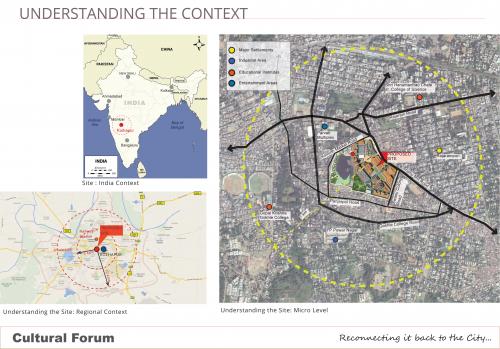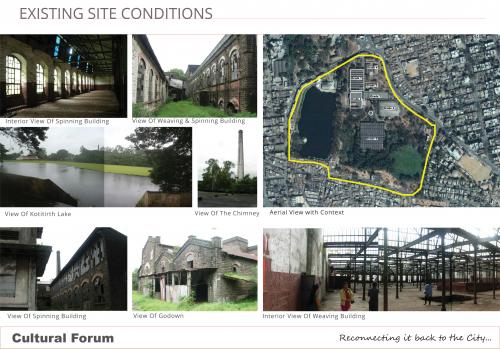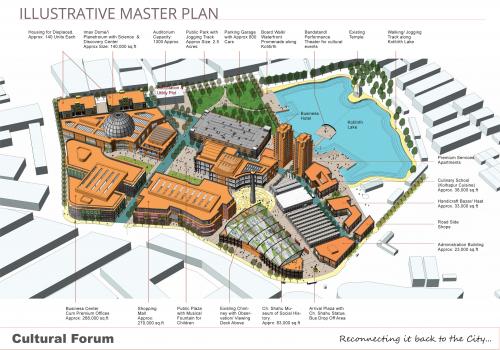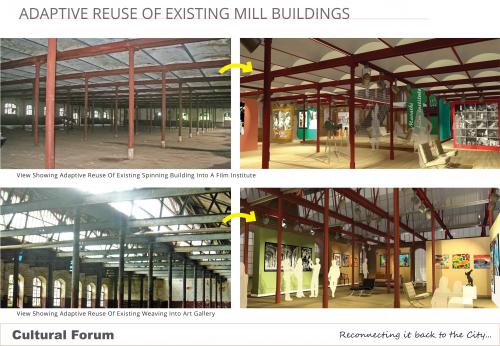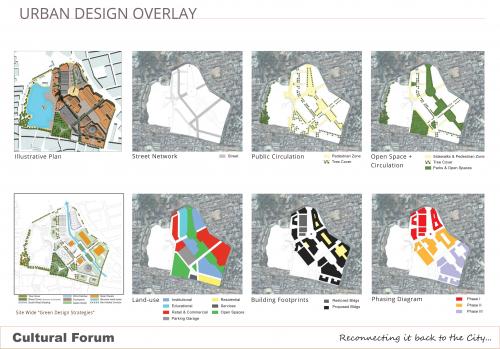
Cultural Forum: Reconnecting it back to the City, Kolhapur. India

Location: Kolhapur, Maharashtra, India. 1920's Industrial Neighborhood
Context
The site, a 30 acre defunct textile mill complex, was started at the turn of the 19th century, by the erstwhile ruler of Kolhapur, a city located 300 Kms south of Mumbai in India. The ruler (name withheld as per completion guidelines), known for his social engineering used the opportunity to empower local residents and compete in Industrial age(C-1906). Post-independence the mill was acquired by government before finally shutting down in 1970’s amidst protest from displaced workers.
The project site is strategically located at the centre of city of Kolhapur. Today it is a void in the city fabric with a collection of derelict historic buildings and a towering chimney which today stands as a beacon and a reminder of the mill’s glorious past. The site is surrounded by light industrial use on south west side and residential neighborhoods on north and east side. An existing lake with a small temple located along the west boundary of site forms am attractive backdrop for the site.
The project brief not only called for a memorial with cultural and civic uses to honor the memory of the ruler and city’s weaving heritage but also identify opportunities to make this an economically sustainable place of civic heritage.
Vision
The vision for the project comprised of series of strategies to fill the existing void with activities & reconnect the site back to the city. The project seeks to provide ample
Ample opportunities for learning, working, and entertaining through a vibrant ‘Cultural Forum’ in the heart of the city. Programmatically the goal is to create a fully sustainable development that meets the objective of creating economically, socially, culturally and environmentally sustainable place. Ultimately the goal is to create a vibrant cultural place with attractive public realm for the residents of Kolhapur
The Proposal:
Conceived as a “Mixed use Cultural Forum”, the proposal consists of a 47,000 sq.ft Adaptive Reuse to house Artist’s Village & a Film Institute, an 83,000 sq.ft Cultural History Museum, 540,000 sq.ft Commercial complex containing a mix of retail and office uses, 140,000 sq.ft Imax Dome/Planetarium/Science Center, 33,000 sq.ft Culinary school with restaurants and cafes, a 150 room Business Hotel, 800 car parking garage and 140 residential units for displaced workers. In the public realm, the project comprises of a memorial, a civic square, a panhandle plaza, a public park and a boardwalk with Café’s along existing lake.
The site has three grade one and grade 2 heritage buildings with few others in a decorated stage. The skyline of the site is defined with a strong silhouette of north light trusses and a chimney which acts as an identity element. The proposal seeks to convert these heritage buildings into adaptive reuse comprising an artist’s village, a culinary school and a small film institute. To compliment these uses and create a “vibrant cultural forum” the rest of the program was distributed into a mix of cultural, educational, commercial and residential facilities for the displaced workers.
At a diagram level, three main nodal axis points which are major landmarks of Kolhapur are identified. The chimney is used as a fulcrum to connect the “Cultural Forum” to different these axis points. Conceived as a collage of street wall buildings, pathways and public places, the site is divided into small blocks with distinct programmatic elements.
The entrance to the cultural forum is distinctly marked by the Cultural History Museum with o very iconic roof form. Upon arrival, visitors go through series of experiences in the public realm starting with a “walk of remembrance” as a memorial to the erstwhile ruler, an interpretive wall to showcase the history of the site, a public square with chimney converted into viewing deck, a panhandle plaza with retail and educational facilities culminating into a waterfront promenade with amphitheatre and a band stand within the existing lake.
Read more at this project's website.
Lessons learned: Post-independence Indian cities have grown at rapid pace. The absence of any cohesive urban planning legacy and long term vision for the majority of Indian cities has resulted into fragmented urban fabric of individual buildings and isolated places with an overall lack of sense of place. The great tradition and heritage of our cities from Rajasthan and mogul era is completely lost. In almost all instances, be it private sector housing or public sector civic buildings, it’s the culture of individual standalone buildings and architecture, devoid of any contextual reference, that has been the determining factor on which decisions are made in developing such civic projects. The placemaking and contextual response has been conspicuously missing from the collective psyche of the decision makers. The project in the form of a Memorial with “Cultural Forum” demonstrates that universal design principles and good urbanism with intelligent programming can be applied to varied contexts and under various circumstances. Such an approach and design response can (hopefully) act as an agent of change and a catalyst …the new future projects can draw upon these responses and use such projects as a starting reference point around which future communities can be developed. The project is an attempt at showcasing local administration and stakeholders that good placemaking, intelligent programing, contextual responses and architecture can co-exist and it plays an important role in equal measure in shaping our civic places, towns and cities.
Transect Zone(s): T5 center.
Status: Proposed
Guiding Charter Principle(s): Principle 16) Concentrations of civic, institutional, and commercial activity should be embedded in neighborhoods and districts, not isolated in remote, single-use complexes.27) Preservation and renewal of historic buildings, districts, and landscapes affirm the continuity and evolution of urban society.
Project or Plan's Scale: District
Features: Bus transit, Live/work, Mixed uses, Sustainable infrastructure, Transit oriented development, Waterfront.
Land area (in acres): 32
Total built area (in sq. ft.): 867000
Total project cost (in local currency): 1
Retail area (in sq. ft.): 540000
Office area (in sq. ft.): 140000
Industrial area (in sq. ft.):
Number of hotel units: 150
Number of residential units (include live/work): 140
Civic uses (type and size): Memorial, Urban Plazas, Promenade
Parks & green space (in acres): 6
Residential types: Low-rise flats, Live/work.
Project team designers: Swapnil Patil, Director (Design)/ Urban Designer, Beri Urban & Environmental Planners
Project team developers: KMC
Previous site status: Brownfield (former industrial)
Starting/Ending date of construction/implementation: 2015 - 2025


